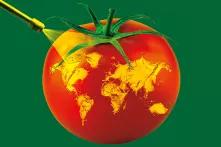
Studies regularly reveal how pesticides contaminate rivers, lakes, coastal waters and groundwater. The pollutants often originate in agriculture and enter surface water via infiltration, surface runoff and drift.

Mixtures of chemicals such as pesticides, biocides, pharmaceuticals and industrial chemicals have been detected in rivers, lakes, and other surface water all over Europe. These pollutions affect the living conditions of aquatic organisms and the general ecological status of water bodies in Europe. Stressors such as climate and land use change or water scarcity make the situation worse. In other parts of the world such as China or South Africa the water quality of rivers, lakes, and groundwater is even more threatened by pesticides. There, pollution has particularly far-reaching consequences because there is less overall availability of freshwater and the water bodies harbour a great deal of biodiversity.
With regards to water pollution by pesticides, one figure in the European approval process is particularly meaningful: the regulatory acceptable concentration (RAC) per active ingredient. The assumption is that the harmful effects of pesticides on aquatic life are low as long as this concentration is not exceeded in the water. Despite this requirement, small streams, which make up a large proportion of European watercourses, are regularly contaminated with pesticides, according to environmental monitoring. They are often located in the middle of agricultural land and thus particularly exposed to pesticides, as a recently published study by the Helmholtz-Centre for Environmental Research together with the German Environment Agency proved.
A study by the European Environmental Agency shows that levels of pesticides exceeding national thresholds were measured in up to one-third of all reported monitoring sites in European surface waters from 2013 to 2019. The pesticides that most often exceed thresholds are the insecticides imidacloprid and malathion, and the herbicides metolachlor and metazachlor.
At global scale, the situation is even more alarming. A study from scientists from a German University provides a comprehensive meta-analysis of 838 peer-reviewed studies that evaluates the exposure of surface waters to insecticides. Among the 11,300 insecticide concentrations detected, more than half exceeded their threshold levels – so the biological integrity of global water resources is under substantial threat. Because residue analyses are too expensive for many local scientific institutes and there is a lack of national monitoring data in the Global South, one can assume that the figures would likely be even greater with more data. What is already clear, though, is that global chemical pollution levels have exceeded planetary boundaries.
It is certain that agricultural pesticides are a crucial environmental stressor for insects in small water bodies. Studies show that in polluted streams in Germany, populations of sensitive species such as dragonflies and caddisflies decrease significantly. But not only small streams are at risk: Pesticides ultimately end up in the sea via rivers. Environmental experts have been studying the presence of pesticides in harbor seals and other marine mammals in the EU LIFE APEX project. The results show that the pesticides that are particularly problematic are those that persist for long periods of time in the environment and can accumulate and pass from one species to the next through the food chain. One example is hexachlorobenzene (HCB). This pesticide, which was originally used as fungicide, has been banned in European agriculture for 40 years. And yet dolphins, porpoises and seals in European seas are still heavily contaminated today.
Through rain infiltration or leaching, pesticides move into the ground water, where they degrade slowly. A study in Germany detected active ingredients at almost one third of the monitoring sites. Degradation products were found at even 58 percent of the monitoring sites. In Italy, about one third of the groundwater bodies investigated showed pollution by pesticides. Frequently detected pesticide compounds in surface water and groundwater include glyphosate and its degradation product AMPA. A mandatory threshold also for degradation products would allow better regulation – so far there are only non-binding recommendations. Another important measure that could protect water bodies from pesticides is establishing continuous riparian buffer zones, which additionally provide an important habitat for plants and migration corridors for animals. Such riparian buffers in which the use of pesticides is prohibited are mandatory only in a few countries. In many regions of the Global South they are practically not feasible at all, as the agricultural area is often smaller than the required width of the riparian buffer zone.
Environmental experts point to the need of an agricultural turnaround: A comprehensive reduction of pesticide pollution of water can only succeed through restructuring conventional agriculture towards less use of chemical pesticides. Protecting soils and improving their quality could prevent erosion which in turn reduces the runoff of pesticides.
Based on an article by Falk Hilliges, Kristina Hitzfeld, Jan Koschorreck and Alexandra Müller.

